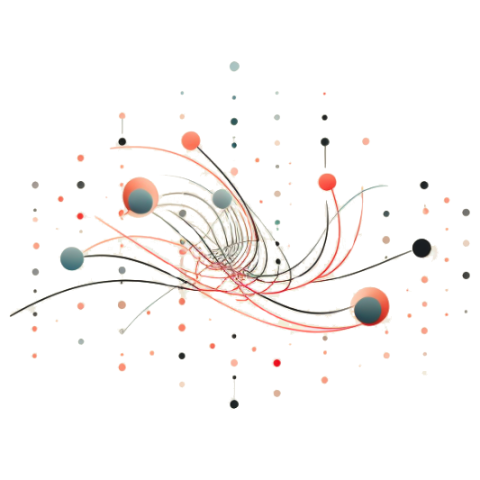
Dynamic AI
Co-Creation
A Human-Centered ApproachCreated through the Digtal Pubishing Initiative at The Creative Media and Digital Culture program, with support of the OER Grants at Washington State University Vancouver.


Pioneers like Hiller and Isaacson showed in 1957 how computers could compose music. Today, modern AI tools like AIVA and Soundful generate polyphonic, emotionally nuanced compositions that inspire—but don’t replace—human creativity. AI thus serves as a collaborative partner, helping shape melodies, harmonies, and structures.
Music has always been intertwined with technology. From the earliest bone flutes and lutes to the piano, phonograph, and synthesizer, each innovation reshaped how humans composed and experienced sound. Many of these breakthroughs weren’t just new instruments—they were new ways of thinking. Consider the fugue: a rigorous, almost algorithmic structure where voices enter, repeat, and intertwine according to rules. Long before computers, composers like Bach were writing what we might now see as “code” for music—carefully designed patterns that unfolded into complex beauty.
By the 20th century, machine‑based music became explicit. Player pianos rolled out perforated “programs,” the Theremin let performers play invisible electromagnetic fields, and the tape studio became a laboratory for splicing, reversing, and looping sound. Each of these technologies expanded music, but none replaced human musicianship—they offered new rules to bend, new possibilities to play with.
Computers pushed this even further. Early algorithmic composers used punch cards and mainframes to generate scores; pioneers like Max Mathews (creator of MUSIC I) turned the computer itself into an instrument. Today’s generative AI tools inherit that lineage, but they also challenge us: if anyone can summon an orchestra or an alien soundscape from a text prompt, how do we keep music a deeply human practice?
This chapter explores AI audio as an iterative, human‑centered art. AI can generate melodies, textures, and voices instantly—but the artistry lies in how we select, layer, remix, and refine those raw outputs into something meaningful. Like Bach at his fugue desk or Brian Eno in the tape studio, the goal is to loop back, listen critically, and shape the music by hand, ear, and intuition.
Musical AI must master several layers of complexity:
To tackle these challenges, AI composers employ:
These models—particularly in tools like AIVA and Soundful—allow creators to generate full-length pieces, customize style, and iterate through drafts quickly. While AI simplifies repetitive tasks, the human role remains crucial: editing, choosing emotional direction, and giving artistic nuance. That’s where the music truly comes alive.
The evolution of AI voice synthesis has been a remarkable journey, from the mechanical speech synthesis of the early 20th century to the seamless mimicry of human speech achieved by modern models like Eleven Labs and HeyGen Labs. Early efforts, such as the Voder demonstrated at the 1939 World's Fair, relied on manual control of a keyboard and foot pedals to produce speech sounds. While innovative, these early systems were limited in expressiveness and naturalness.
In the 1950s and 1960s, formant synthesis emerged, using knowledge-based algorithms to simulate the resonant frequencies of the human vocal tract. Although this approach represented a significant advancement, the resulting speech often sounded robotic. The 1990s saw the rise of concatenative synthesis, which involved stitching together small units of recorded speech. This method greatly improved naturalness but still struggled with intonation and emotion.
Recent advances in deep learning have revolutionized AI voice generation. Techniques like WaveNet, introduced by DeepMind in 2016, leverage Convolutional Neural Networks (CNNs) and Recurrent Neural Networks (RNNs), including Long Short-Term Memory (LSTM) networks, to produce speech that closely mimics the human voice in terms of naturalness, intonation, and emotion. These models are capable of generating highly realistic and expressive synthetic voices that can be tailored to a wide range of applications, from audiobook narration and virtual assistants to video game character voices.
However, the powerful capabilities of AI voice modeling come with significant challenges and risks. One of the primary challenges is achieving naturalness and expressiveness in synthesized speech, which involves capturing human emotions, tone, and style in a way that feels authentic. Additionally, there is the need for language and accent diversity, which requires extensive datasets and sophisticated modeling to ensure inclusivity and accuracy across a vast array of dialects and languages. Computational demands also pose a challenge, as high-quality voice synthesis requires substantial resources, making real-time processing with minimal latency difficult to achieve on low-power devices.
Another critical aspect is personalization and adaptability, where AI systems must be capable of adapting to individual voices and speaking styles to create personalized speech generation. Despite these challenges, the benefits of AI voice synthesis are profound, particularly in enhancing accessibility. AI-generated voices can provide high-quality audio readings of text for visually impaired individuals, offering greater access to information and literature. These tools can also assist those who have difficulty reading due to dyslexia or other learning disabilities by converting written content into easily understandable audio.
Beyond accessibility, AI voice technology has the potential to revolutionize education by enabling the creation of personalized and engaging learning materials. It can enhance user experiences in customer service, entertainment, and communication by providing natural-sounding, responsive, and emotionally expressive voices in various applications. As AI voice synthesis continues to advance, it is essential to balance its powerful capabilities with considerations of ethical use, ensuring that the technology serves to enhance human experience while safeguarding against potential harms. The potential for misuse, such as creating deepfakes or impersonating individuals, underscores the need for responsible use and ethical guidelines in the development and deployment of AI voice technologies.
AI tools now let creators quickly generate realistic and imaginative sound effects using just text prompts. These tools are useful for film, games, VR, and interactive media, making it easier to create immersive soundscapes without recording or downloading audio libraries.
You can describe a sound—like “wind through trees at night” or “robot footsteps”—and the AI generates audio that fits. This opens up new ways to create sound effects, especially for small teams or solo creators.
These tools give storytellers the power to create original audio faster and more easily than ever. They’re also great for teaching students how sound design supports visual storytelling—and how to shape that with AI.
AI has made music and sound creation more accessible than ever. With just a few prompts, creators can compose music, build soundscapes, and remix audio—without needing deep technical skills or traditional software.
These tools are great for filmmakers, podcasters, educators, game developers, and anyone experimenting with sound. They save time, reduce cost, and allow for rapid prototyping of ideas.
These platforms help anyone—from hobbyists to pros—quickly create compelling audio and experiment with new sound styles. They're transforming music from something made only in studios to something made anywhere.
AI can flood you with sound. But music only becomes meaningful when you listen and decide. The practice is iterative: generate, audition, cut, tweak, re‑generate. A choral texture might become a whispering pad under a scene. A robotic melody might inspire a live instrument to “answer” it. The key is to keep looping back, treating every AI output as a suggestion, not a solution.
AI is changing how music is made, performed, and understood. It helps artists write songs, compose melodies, remix audio, and even perform live. Projects like Taryn Southern’s I AM AI and Björk’s Kórsafn show how human musicians and AI can work together to create original works.
AI acts as a creative partner—offering new sounds, suggesting structures, or transforming existing ideas. It doesn’t replace musicians but expands what’s possible in composition and sound design.
Tools now analyze music structure, harmonies, rhythms, and emotions. This lets artists refine their work with better insight and control. AI mastering and production tools give more creators access to high-quality results without studio resources.
In live shows, AI can improvise with musicians, creating responsive and evolving soundscapes. This real-time collaboration adds depth to performances and creates entirely new concert experiences.
As AI becomes more common in the music world, the focus shifts from whether machines can create art to how humans and machines can create together. The future of music lies in this creative partnership.
In this assignment, you'll use AI tools to produce a short original audio project. It can be a soundtrack, concept album, or audio narrative combining music, voice, and sound effects. Your goal is to push AI tools beyond imitation—create something strange, beautiful, and new.
This project is a chance to explore collaboration with machines as creative partners. Use iteration, imagination, and your own judgment to guide the tools toward something expressive and original.
AI is rapidly changing how music, voice, and sound are created, raising both creative and ethical questions. These discussion prompts invite deeper thinking about how we balance artistic innovation with human values in the age of AI: